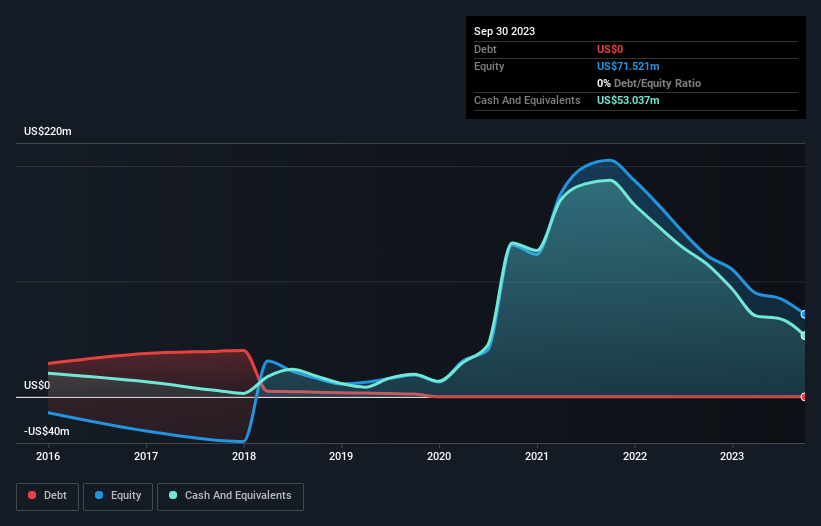
Just because a business does not make any money, does not mean that the stock will go down. For example, although software-as-a-service business Salesforce.com lost money for years while it grew recurring revenue, if you held shares since 2005, you'd have done very well indeed. But while the successes are well known, investors should not ignore the very many unprofitable companies that simply burn through all their cash and collapse.
Given this risk, we thought we'd take a look at whether Vaxart (NASDAQ:VXRT) shareholders should be worried about its cash burn. In this article, we define cash burn as its annual (negative) free cash flow, which is the amount of money a company spends each year to fund its growth. Let's start with an examination of the business' cash, relative to its cash burn.
View our latest analysis for Vaxart
How Long Is Vaxart's Cash Runway?
You can calculate a company's cash runway by dividing the amount of cash it has by the rate at which it is spending that cash. In September 2023, Vaxart had US$53m in cash, and was debt-free. In the last year, its cash burn was US$92m. That means it had a cash runway of around 7 months as of September 2023. That's quite a short cash runway, indicating the company must either reduce its annual cash burn or replenish its cash. The image below shows how its cash balance has been changing over the last few years.

How Is Vaxart's Cash Burn Changing Over Time?
In our view, Vaxart doesn't yet produce significant amounts of operating revenue, since it reported just US$4.2m in the last twelve months. As a result, we think it's a bit early to focus on the revenue growth, so we'll limit ourselves to looking at how the cash burn is changing over time. With the cash burn rate up 4.3% in the last year, it seems that the company is ratcheting up investment in the business over time. That's not necessarily a bad thing, but investors should be mindful of the fact that will shorten the cash runway. Clearly, however, the crucial factor is whether the company will grow its business going forward. For that reason, it makes a lot of sense to take a look at our analyst forecasts for the company.
Can Vaxart Raise More Cash Easily?
Since its cash burn is increasing (albeit only slightly), Vaxart shareholders should still be mindful of the possibility it will require more cash in the future. Companies can raise capital through either debt or equity. Commonly, a business will sell new shares in itself to raise cash and drive growth. By looking at a company's cash burn relative to its market capitalisation, we gain insight on how much shareholders would be diluted if the company needed to raise enough cash to cover another year's cash burn.
Vaxart has a market capitalisation of US$109m and burnt through US$92m last year, which is 85% of the company's market value. That suggests the company may have some funding difficulties, and we'd be very wary of the stock.
How Risky Is Vaxart's Cash Burn Situation?
As you can probably tell by now, we're rather concerned about Vaxart's cash burn. In particular, we think its cash burn relative to its market cap suggests it isn't in a good position to keep funding growth. While not as bad as its cash burn relative to its market cap, its increasing cash burn is also a concern, and considering everything mentioned above, we're struggling to find much to be optimistic about. The measures we've considered in this article lead us to believe its cash burn is actually quite concerning, and its weak cash position seems likely to cost shareholders one way or another. On another note, we conducted an in-depth investigation of the company, and identified 4 warning signs for Vaxart (1 doesn't sit too well with us!) that you should be aware of before investing here.
If you would prefer to check out another company with better fundamentals, then do not miss this free list of interesting companies, that have HIGH return on equity and low debt or this list of stocks which are all forecast to grow.
New: Manage All Your Stock Portfolios in One Place
We've created the ultimate portfolio companion for stock investors, and it's free.
• Connect an unlimited number of Portfolios and see your total in one currency
• Be alerted to new Warning Signs or Risks via email or mobile
• Track the Fair Value of your stocks
Have feedback on this article? Concerned about the content? Get in touch with us directly. Alternatively, email editorial-team (at) simplywallst.com.
This article by Simply Wall St is general in nature. We provide commentary based on historical data and analyst forecasts only using an unbiased methodology and our articles are not intended to be financial advice. It does not constitute a recommendation to buy or sell any stock, and does not take account of your objectives, or your financial situation. We aim to bring you long-term focused analysis driven by fundamental data. Note that our analysis may not factor in the latest price-sensitive company announcements or qualitative material. Simply Wall St has no position in any stocks mentioned.
About NasdaqCM:VXRT
Vaxart
A clinical-stage biotechnology company, discovers and develops oral recombinant protein vaccines based on its proprietary oral vaccine platform.
Excellent balance sheet and good value.

